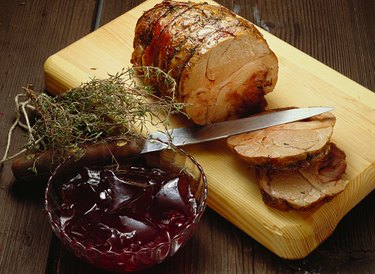
Low in price and high in flavor, pork roasts make a delicious and heart-healthy meal. All pork roasts are not created equal, however. For instance, two popular cuts, the pork shoulder roast and pork sirloin roast, are similar in name only. Proper preparation for your particular piece of pork ensures that for just a few dollars you will be eating high on the hog.
Location
Video of the Day
Pork sirloin roasts and pork shoulders are cut from two different sections of a butchered pig. Sirloin roasts come from loin of the pig, which spreads to cover the back and sides of the hog. At the front of the loin region you will find country-style and baby-back ribs, while the back of the loin region, closest to the tail, produces pork sirloin. Shoulder cuts are located close to the front of the pig and are divided into two categories. The top shoulder is called the "Boston butt," while a cut from the lower shoulder and leg is called an "arm picnic" shoulder. Both shoulder cuts produce pork shoulder roasts.
Video of the Day
Cuts
A pork sirloin roast is typically sold as a whole roast ranging from 2 to 4 lbs. in weight, with bone-in cuts registering the higher weights. A sirloin roast that has been sliced across the grain of the meat is ideal, as it will yield tender, flavorful pieces with short fibers. Pork sirloin is often sliced and sold as thick pork sirloin steaks. Pork shoulder roasts differ noticeably depending on the location from which they are butchered. A Boston butt is typically deboned, but an arm picnic shoulder cut may contain bones from the leg shank of the hog and will present a challenge when it is time to carve the roast. Both Boston and arm picnic shoulder roasts may be sliced and sold as pork steaks.
Marbling
The presence of ribbons of fat amongst the muscles of a particular cut of meat determines whether or not the meat is "marbled," and it is a source of disparity between pork sirloin and pork shoulder roasts. Pork sirloin roasts lack the marbled fat associated with pork shoulder roasts. The rear loin of the pig is tougher and leaner, so while a pork sirloin roast is full of flavor, it can dry out quickly unless cooked properly. Boston butt shoulder roasts are usually exceptionally well-marbled, and it is recommended that the roasts be netted and tied during cooking to keep from falling apart as the fat melts. Arm picnic shoulder roasts are marbled as well, though less so than Boston butt shoulder roasts.
Cooking
Pork sirloin and shoulder roasts require different methods of cooking for the best results. Slow cooking over low heat makes the most tender and juicy pork sirloin roast. Roast a pork sirloin roast for approximately two hours at 225 degrees Fahrenheit. Barbecuing is also good for pork sirloin roasts, especially if they have been sliced into thick steaks prior to cooking. Pork shoulder roasts are suited to a wider variety of cooking methods, as their marbling will keep them from drying out.